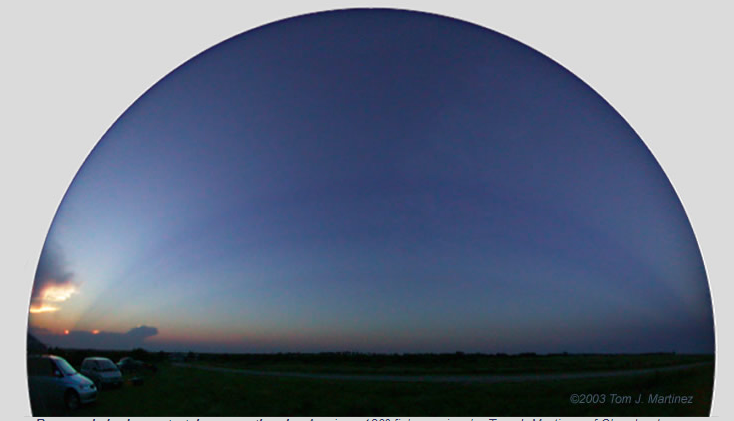Sky-wide rays and shadows
Sky-wide Rays and Shadows: A Phenomenon of Atmospheric Optics
Have you ever witnessed the mesmerizing sight of rays and shadows stretching across the sky? This captivating phenomenon, known as sky-wide rays and shadows, offers a unique perspective on the interplay between light and the atmosphere. In this article, we will delve deeper into this enchanting occurrence, exploring its characteristics and shedding light on its lesser-known aspects.
At first glance, these rays may appear to be converging towards the sun as they stretch across the western sky. However, this is merely a perspective effect. In reality, the rays are parallel to each other, forming columns of sunlit and shadowed air. As they extend further into the distance, they create an illusion of convergence towards the sun. This optical illusion adds to the allure of the spectacle, creating a sense of depth and dimension in the sky.
But the sky-wide rays do not stop at their apparent convergence towards the sun. As they reach the eastern horizon, they once again seem to converge, this time towards the antisolar point. These rays in the antisolar direction are known as anti-crepuscular rays. Interestingly, these anti-crepuscular rays are essentially the same objects as the familiar crepuscular rays that extend from the sun towards the opposite horizon. The distinction lies in their direction and position in relation to the observer.
While observing the eastern sky, you may notice another intriguing element: a dark wedge-shaped shadow that begins right of center and reaches its highest point where the anti-crepuscular rays converge. This shadow is none other than the Earth's own shadow cast upon the atmosphere. As sunlight passes through the Earth's atmosphere, it interacts with various particles and molecules, creating this captivating shadow that adds an extra layer of visual complexity to the sky-wide rays phenomenon.
To fully appreciate the beauty of sky-wide rays and shadows, it is important to understand the role of atmospheric conditions in their formation. These optical phenomena occur when sunlight interacts with particles, such as dust, water droplets, and ice crystals, present in the atmosphere. The particles scatter and refract the sunlight, creating the intricate patterns of rays and shadows that grace our skies.
It is worth noting that the appearance of sky-wide rays and shadows can vary depending on the time of day, weather conditions, and the observer's location. For instance, during sunrise or sunset, when the sun is closer to the horizon, the rays may appear more pronounced and vibrant, casting longer shadows across the sky. Similarly, atmospheric conditions, such as the presence of clouds or haze, can influence the visibility and intensity of these phenomena.
In conclusion, sky-wide rays and shadows offer a captivating glimpse into the wonders of atmospheric optics. These parallel columns of sunlit and shadowed air create a visual spectacle that stretches across the sky, seemingly converging towards the sun and the antisolar point. The interplay between sunlight and atmospheric particles gives rise to this enchanting phenomenon, while the Earth's own shadow adds an extra dimension to the spectacle. Next time you find yourself gazing at the sky, take a moment to appreciate the intricate beauty of sky-wide rays and shadows, a testament to the awe-inspiring nature of our atmosphere.

Rays and shadows stretch across the sky. A unique 180 fiseye view by Tom J. Martinex of Cleveland, Missouri. "While waiting for the sky to get dark at a star party near Marion, Kansas, I saw crepuscular rays extend from where the sun was setting, across the sky, to the antisolar point. "Image 2003 Tom J Martinez, Show with permission
The rays are all parallel to each other, real columns of sunlit and shadowed air. In the west, perspective effects make them appear to converge towards the sun as they get more distant. They again appear to converge in the east, this time towards the antisolar point. The rays in the antisolar direction, are called anti-crepuscular. This image shows brilliantly that familiar crepuscular rays and the less well known anti-crepuscular rays are really the same objects.
The easterly sky contains another shadow. Look at the dark wedge shape starting right of center and highest where the anticrepuscular rays converge. This is the shadow of the earth itself cast upon the atmosphere.
Note: this article has been automatically converted from the old site and may not appear as intended. You can find the original article here.
Reference Atmospheric Optics
If you use any of the definitions, information, or data presented on Atmospheric Optics, please copy the link or reference below to properly credit us as the reference source. Thank you!
-
<a href="https://atoptics.co.uk/blog/sky-wide-rays-and-shadows/">Sky-wide rays and shadows</a>
-
"Sky-wide rays and shadows". Atmospheric Optics. Accessed on December 21, 2024. https://atoptics.co.uk/blog/sky-wide-rays-and-shadows/.
-
"Sky-wide rays and shadows". Atmospheric Optics, https://atoptics.co.uk/blog/sky-wide-rays-and-shadows/. Accessed 21 December, 2024
-
Sky-wide rays and shadows. Atmospheric Optics. Retrieved from https://atoptics.co.uk/blog/sky-wide-rays-and-shadows/.